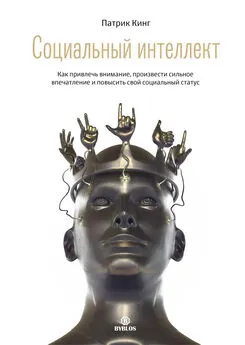Мэттью Либерман - Социальный вид
- Название:Социальный вид
- Автор:
- Жанр:
- Издательство:неизвестно
- Год:2020
- Город:Москва
- ISBN:978-5-00146-614-7
- Рейтинг:
- Избранное:Добавить в избранное
-
Отзывы:
-
Ваша оценка:
Мэттью Либерман - Социальный вид краткое содержание
На русском языке публикуется впервые.
Социальный вид - читать онлайн бесплатно ознакомительный отрывок
Интервал:
Закладка:
3
Banville, Lee. (2002). “Former Vice President Walter Mondale (Democrat).” Online NewsHour. PBS. Retrieved March 26, 2011.
4
Fein, S., Goethals, G. R., & Kugler, M. B. (2007). Social influence on political judgments: The case of presidential debates. Political Psychology, 28(2), 165–192.
5
Pronin, E., Lin, D. Y., & Ross, L. (2002). The bias blind spot: Perceptions of bias in self versus others. Personality and Social Psychology Bulletin, 28(3), 369–381.
6
Dunbar, R. I. M. (1998). The social brain hypothesis. Evolutionary Anthropology, 6, 178–190.
7
Fox, M. D., Snyder, A. Z., Vincent, J. L., Corbetta, M., Van Essen, D. C., & Raichle, M. E. (2005). The human brain is intrinsically organized into dynamic, anticorrelated functional networks. Proceedings of the National Academy of Sciences of the United States of America, 102(27), 9673–9678.
8
Новые области коры головного мозга, составляющие у человека (в отличие от животных) ее основную часть. Неокортекс отвечает за высшие нервные функции – сенсорное восприятие, выполнение моторных команд, осознанное мышление, речь.
9
Herrmann, E., Call, J., Hernández-Lloreda, M. V., Hare, B., & Tomasello, M. (2007). Humans have evolved specialized skills of social cognition: The cultural intelligence hypothesis. Science, 317(5843), 1360–1366.
10
Costanzo, P. R., & Shaw, M. E. (1966). Conformity as a function of age level. Child Development, 967–975.
11
Shulman, G. L., Corbetta, M., Buckner, R. L., Fiez, J. A., Miezin, F. M., Raichle, M. E., & Petersen, S. E. (1997). Common blood flow changes across visual tasks: I. Increases in subcortical structures and cerebellum but not in nonvisual cortex. Journal of Cognitive Neuroscience, 9(5), 624–647; Shulman, G. L., Fiez, J. A., Corbetta, M., Buckner, R. L., Miezin, F. M., Raichle, M. E., & Petersen, S. E. (1997). Common blood flow changes across visual tasks: II. Decreases in cerebral cortex. Journal of Cognitive Neuroscience, 9(5), 648–663.
12
Mckiernan, K. A., Kaufman, J. N., Kucera-Thompson, J., & Binder, J. R. (2003). A parametric manipulation of factors affecting task-induced deactivation in functional neuroimaging. Journal of Cognitive Neuroscience, 15(3), 394–408.
13
Raichle, M. E., MacLeod, A. M., Snyder, A. Z., Powers, W. J., Gusnard, D. A., & Shulman, G. L. (2001). A default mode of brain function. Proceedings of the National Academy of Sciences, 98(2), 676–682.
14
На самом деле все не однозначно. В сети пассивного режима есть маленькая подсеть, которая обычно не активируется в исследованиях социального познания, но б о льшая часть обеих сетей пересекается.
15
То есть принятой установкой на интерпретацию действий другого.
16
Gao, W., Zhu, H., Giovanello, K. S., Smith, J. K., Shen, D., Gilmore, J. H., & Lin, W. (2009). Evidence on the emergence of the brain’s default network from 2-week-old to 2-year-old healthy pediatric subjects. Proceedings of the National Academy of Sciences, 106(16), 6790–6795; Smyser, C. D., Inder, T. E., Shimony, J. S., Hill, J. E., Degnan, A. J., Snyder, A. Z., & Neil, J. J. (2010). Longitudinal analysis of neural network development in preterm infants. Cerebral Cortex, 20(12), 2852–2862.
17
Малкольм Г. Гении и аутсайдеры. Почему одним все, а другим ничего?М.: Манн, Иванов и Фербер, 2019.
18
Gladwell, M. (2008). Outliers: The Story of Success. New York: Little, Brown; Anders Ericsson, K. (2008). Deliberate practice and acquisition of expert performance: A general overview. Academic Emergency Medicine, 15(11), 988–994.
19
Dunbar, R. I., Marriott, A., & Duncan, N. D. (1997). Human conversational behavior. Human Nature, 8(3), 231–246.
20
Spunt, R. P., Meyer, M. L., & Lieberman, M. D. (under review). Social by default: Brain activity at rest facilitates social cognition; Buckner, R. L., Andrews-Hanna, J. R., & Schacter, D. L. (2008). The brain’s default network. Annals of the New York Academy of Sciences, 1124(1), 1–38.
21
Rubin, E. (1915/1958). Figure and ground. In D. C. Beardslee & M. Wertheimer (Eds.). Readings in Perception. Princeton: NJ: Van Nostrand, pp. 194–203.
22
Agafonov, A. I. (2010). Priming effect as a result of the nonconscious activity of consciousness. Journal of Russian and East European Psychology, 48(3), 17–32.
23
Wechsler, David (1958). The Measurement and Appraisal of Adult Intelligence, 4th ed. Baltimore: Williams & Wilkins, p. 75.
24
Vitale, S., Cotch, M. F., & Sperduto, R. D. (2006). Prevalence of visual impairment in the United States. JAMA: Journal of the American Medical Association, 295(18), 2158–2163.
25
Stravynski, A., & Boyer, R. (2001). Loneliness in relation to suicide ideation and parasuicide: A population-wide study. Suicide and Life-Threatening Behavior, 31(1), 32–40.
26
Silk, J. B. (2002). Using the “F”-word in primatology. Behaviour, 421–446.
27
Fiske, A. P. (1991). Structures of Social Life: The Four Elementary Forms of Human Relations: Communal Sharing, Authority Ranking, Equality Matching, Market Pricing. New York: Free Press.
28
Bureau of Labor Statistics: http://www.bls.gov/home.htm.
29
“U.S. charitable giving approaches $300 billion in 2011”: http://www.reuters.com/article/2012/06/19/us-usa-charity-idUSBRE85I05T20120619.
30
Fox, M. D., Snyder, A. Z., Vincent, J. L., Corbetta, M., Van Essen, D. C., & Raichle, M. E. (2005). The human brain is intrinsically organized into dynamic, anticorrelated functional networks. Proceedings of the National Academy of Sciences of the United States of America, 102(27), 9673–9678.
31
Van Overwalle, F. (2011). A dissociation between social mentalizing and general reasoning. NeuroImage, 54(2), 1589–1599.
32
Anticevic, A., Repovs, G., Shulman, G. L., & Barch, D. M. (2010). When less is more: TPJ and default network deactivation during encoding predicts working memory performance. NeuroImage, 49(3), 2638–2648; Li, C. S. R., Yan, P., Bergquist, K. L., & Sinha, R. (2007). Greater activation of the “default” brain regions predicts stop signal errors. NeuroImage, 38(3), 640–648.
33
Hayashi, M., Kato, M., Igarashi, K., & Kashima, H. (2008). Superior fluid intelligence in children with Asperger’s disorder. Brain and Cognition, 66(3), 306–310.
34
Roth, G., & Dicke, U. (2005). Evolution of the brain and intelligence. Trends in Cognitive Sciences, 9(5), 250–257.
35
Schoenemann, P. T. (2006). Evolution of the size and functional areas of the human brain. Annual Review of Anthropology, 35, 379–406.
36
Aiello, L. C., Bates, N., & Joffe, T. (2001). In defense of the expensive tissue hypothesis. Evolutionary Anatomy of the Primate Cerebral Cortex. Cambridge: Cambridge University Press, pp. 57–78; Leonard, W. R., & Robertson, M. L. (1992). Nutritional requirements and human evolution: A bioenergetics model. American Journal of Human Biology, 4(2), 179–195.
37
Dunbar, R. I. M. (1998). The social brain hypothesis. Evolutionary Anthropology, 6, 178–190.
38
«Неокортекс» буквально означает «новая кора»; по структуре эта часть у приматов и других млекопитающих различается сильнее по сравнению с другими частями.
39
Dunbar, R. I. (1992). Neocortex size as a constraint on group size in primates. Journal of Human Evolution, 22(6), 469–493; Sawaguchi, T. (1988). Correlations of cerebral indices for “extra” cortical parts and ecological variables inprimates. Brain, Behavior and Evolution, 32(3), 129–140.
40
Schoenemann, P. T. (2006). Evolution of the size and functional areas of the human brain. Annual Review of Anthropology, 35, 379–406.
41
Dunbar, R. I. (2008). Why humans aren’t just Great Apes. Issues in Ethnology and Anthropology, 3, 15–33.
42
Dunbar, R. I. (1993). Coevolution of neocortical size, group size and language in humans. Behavioral and Brain Sciences, 16(4), 681–693.
43
Hill, R. A., & Dunbar, R. I. M. (1998). An evaluation of the roles of predation rate and predation risk as selective pressures on primate grouping behaviour. Behaviour, 411–430.
44
Silk, J. B. (2002). Using the “F”-word in primatology. Behaviour, 421–446.
45
Число возможных диад рассчитывается по формуле [N×(N−1)]/2.
Интервал:
Закладка:







